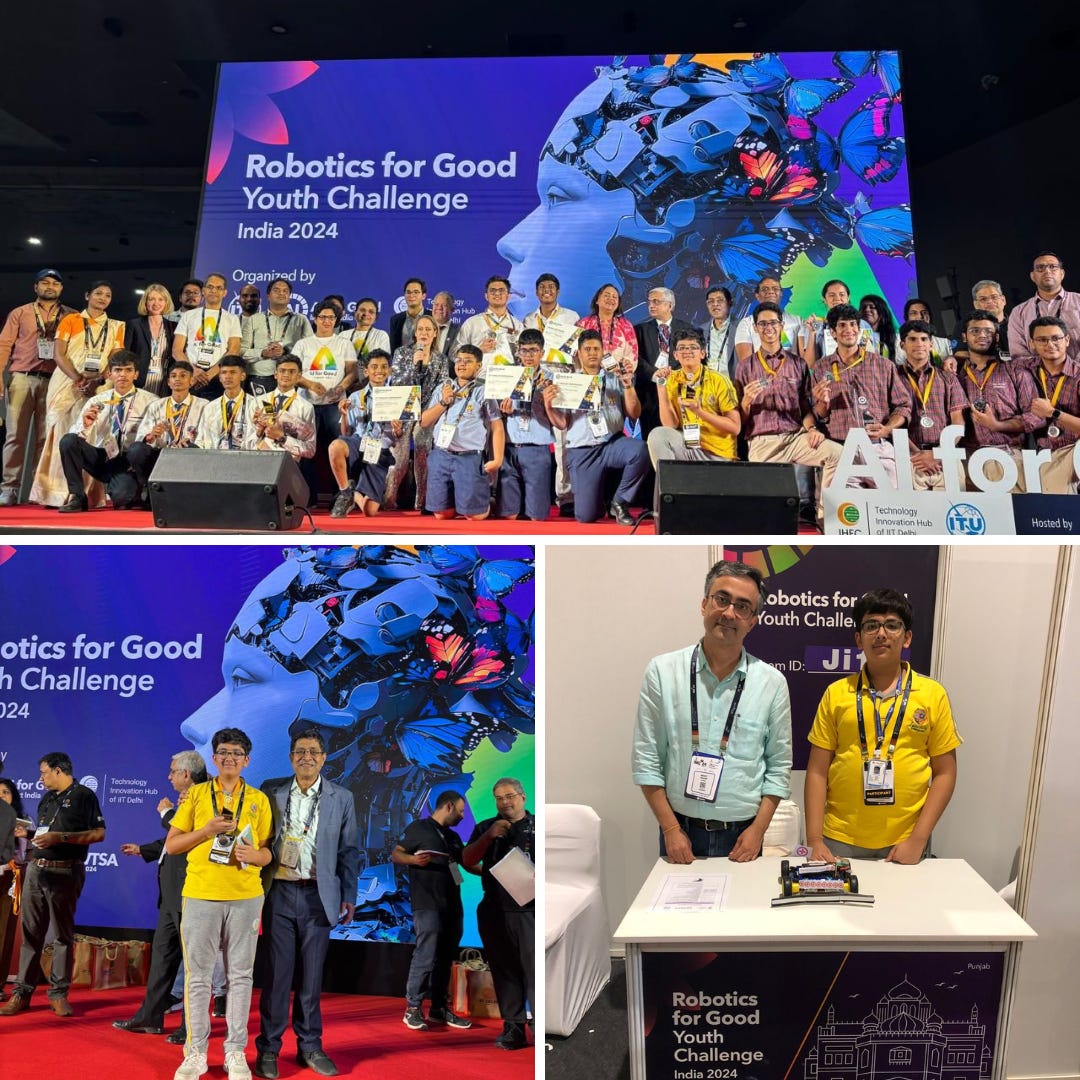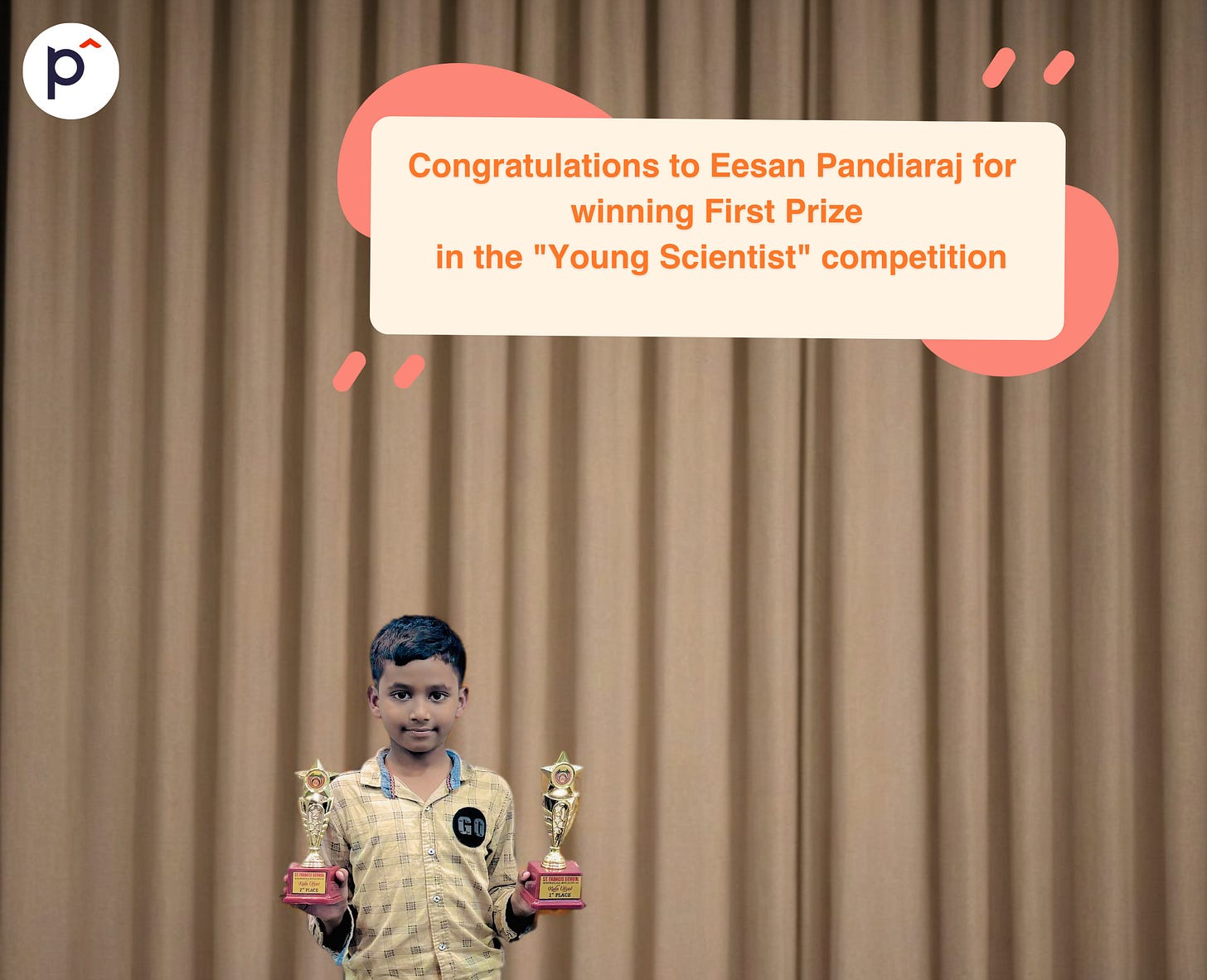Success Flywheel for Kids - How can you use it to help your child achieve greatness
In this newsletter, we discuss what a "Success Flywheel" is and how it can be used to your advantage as a parent to propel your child to greatness.
Before We Learn What the Success Flywheel Is
A big congratulations to Playto Labs student, Vivaan Bhasin, for winning the Bronze Medal in the Juniors Category at the Indian regional finals of the UN-based Global Competition “Robotics for Good Youth Challenge” organized by ITU, a United Nations specialized agency for digital technology! 🏅
Equally thrilled to share that 4 of the top 8 teams in the Juniors Category are from Playto Labs!
All 4 are solo-team members who built their robots entirely on their own, handling both hardware and software — true 10X engineers in the making! 🚀🤖
Special appreciation to their parents for nurturing their potential and supporting them in their journey. We thank them for letting us play a small role in their success.
Another inspiring achievement comes from Eesan Pandiaraj, a 4th grader who recently accomplished not one but two impressive wins. Eesan secured First Prize 🏆 in the "Young Scientist" competition at his school with his "Smart Irrigation Project." On top of that, he earned the 2nd Prize in "Media Masters" for presenting Playto Labs and our teaching methodologies with incredible clarity and confidence.
Stories like these drive us to do more.
We believe every child deserves the opportunity to achieve their full potential — just like Vivaan, Eesan, and many other students at Playto Labs. That’s why we’re excited to introduce a special Black Friday opportunity for parents looking to unlock their child's creativity and innovation.
This could be the first step in your child’s journey toward becoming a 10X engineer or a young scientist, ready to tackle the challenges of the future.
Now let’s dive into the concept of the Success Flywheel and how it drives extraordinary achievements.
What is the Success Flywheel?
The Success Flywheel is a cycle where small wins build momentum, leading to bigger successes. For children, this means:
The child achieves something (could be small)
Each achievement boosts confidence
Increased confidence leads to taking on new larger challenges
New challenges result in more achievements
The cycle continues, gaining momentum
It's important to note that the reverse is also true. If your child experiences failure, it can lead to a loss of confidence, further failures, and a negative bias against that domain. We all hated those subjects we failed in when we were kids!
You can either wait for one of these two flywheels to happen naturally and hope for the best or you can work actively to get your child into a successf flywheel!
To understand this better, let us dive deeper into Competence Motivation Theory by Susan Harter.
Competence Motivation Theory: The Engine of the Success Flywheel
Competence Motivation Theory suggests that children are naturally motivated to engage in tasks where they feel capable. This theory aligns perfectly with the Success Flywheel concept:
Perceived Competence: Children are more likely to engage in activities where they feel competent.
Mastery Attempts: Success in these activities reinforces their sense of competence.
Intrinsic Motivation: This sense of competence fuels internal motivation to continue improving.
Feedback Loop: The cycle of competence, attempt, and success drives the Success Flywheel.
You, as a parent, can hack the 1st step here to your advantage and get your child into the Success Flywheel by making them feel competent. How? Read on..
Key Ideas to Implement the Success Flywheel:
This is how you can help your child enter and stay in the success flywheel.
1. Perceived Competence: The goal here is to make children feel they are “good” at something.
Start with activities where “success can be felt”
Example: Building a Robot or a physical project makes your child “feel” the success in the real world when the robot works. The same success is hard to feel in something more abstract like Coding or Math. Compare these 2 - “Build a robot to save plants by watering at the right time” vs. “Write a code to print Yes if it is an Odd Number.” In both these activities, a simple If Else logic has to be used - In one case, check if the moisture level in the soil is less and turn on/ off the motor. In another case, check if the input number is Odd and print Yes/ No. However, building a robot makes your child “feel” success/ achievement as it is more real world with a real world impact while the other one is too abstract to “feel” anything.
You should also choose areas where your child has natural interests to begin with so your child can “feel” the impact in a better/ bigger way.
Start Small
Remember, the goal is to make your child “feel competent”. Not “teach complex things”. Once you get your child into the Success Flywheel, your child will naturally progress towards complex topics and develop expertise over time. Parents make this mistake of directly jumping to complex topics and fail to trigger the success flywheel.
The first goal is to win. Learning will happen naturally after that.
1.5 Celebrate Big and get Social Validation
Social Validation is one of the biggest factors in building Perceived Competence and Confidence in your child. It makes kids feel they are on the right path and they will win big if they continue on the same path.
How can you use this in your favour? Simple - Share the success of your child with your friends and family. Let the praises from them reach your child!
Celebrate the wins and let your child know how you value them
2. Mastery Attempts: The goal here is to help children keep winning
Gradually increase the challenge level initially
Go slow. Increase the level when you feel your child is ready. In the initial days, always stay in the zone of high confidence and low failures.
Once your child develops enough confidence, push harder but encourage failures as learning opportunities
At some point, your child will cross the comfort zone and attempt hard things. At this stage:
Offer tasks that are neither too easy nor too difficult
Offer praise for effort and strategy, not just results
Try to maintain a sweet spot that maintains motivation and still allows for competence growth.
Use past successes to motivate future efforts
Use phrases like “You can't do it yet, but you're learning!”
Help your child see setbacks as part of the learning process, not a reflection of overall competence
This will help build resilience in your child when your child finally succeeds after initial challenges
Once your child realizes that success from difficult problems is much tastier and more rewarding than success that comes easily, you will be a proud parent!
Don’t rush to this stage. There is no prize for doing it faster. Remember that it is a long journey ahead. Go at a pace that is natural for your child.
3. Intrinsic Motivation:
There is nothing much for you to do here if you do the 1st 2 steps well.
Success combined with social validation is a powerful combination that creates intrinsic motivation in your child to keep achieving more.
All you need to do is to keep the social validations and celebrations to continue.
You may also choose to reward externally, but intrinsic motivation is way more powerful than any external trigger.
4. Feedback Loop
As your child's Success Flywheel gains momentum, powered by growing competence motivation, you may notice:
- Increased overall confidence and self-worth
- Greater willingness to try new things, even in less familiar domains
- Improved performance across various areas (academic, social, physical)
- Enhanced problem-solving skills
- A more positive outlook on challenges
- Stronger intrinsic motivation for learning and growth
Remember, every child's flywheel spins at its own pace, and perceived competence may vary across different domains. Patience, consistency, and unwavering support are key to keeping it in motion.
By applying these principles, you're not just helping your child succeed today – you're equipping them with a powerful mindset for lifelong growth and achievement rooted in a strong sense of competence and intrinsic motivation.
Did you like this approach?
At Playto Labs, we use these (and many more such) concepts in designing our curriculum and teaching methodologies for kids. As a result, we see our students develop a deep interest in technology and master these domains over time. With the confidence gained in our programs, our alumni go on to win awards and scholarships, get admissions to top universities, and even build their own startups.
At Playto Labs, our students are constantly building innovative projects and products that showcase their growing skills and creativity. From designing functional robots to creating impressive tech solutions, our young innovators are applying the principles of the Success Flywheel to achieve remarkable feats. Watch these videos to see firsthand how our curriculum transforms learning into a thrilling adventure, inspiring confidence and a love for technology in every child.
Featured Projects of the Month by Playto Labs Students 🚀
You can implement such strategies at your home too. We will share more useful tips in our upcoming editions of the newsletter.
Also, don’t miss our previous newsletter - I talked to 70 parents who raised highly successful kids — discover their No. 1 parenting style.
Happy parenting!
Team Playto Labs



